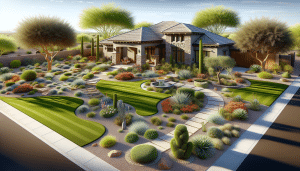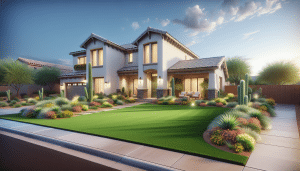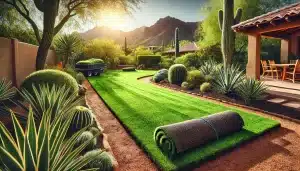In the vibrant and diverse climate of Arizona, maintaining a lush, green lawn can be challenging. The extreme temperatures and arid conditions often make natural grass an impractical choice for many homeowners. This is where artificial turf and artificial grass come into play as viable alternatives. Both options offer a low-maintenance, green solution, but how do you distinguish between the two? In this blog post, we’ll explore the key differences, benefits, and ideal applications of artificial turf and artificial grass.
Contents
Understanding Artificial Turf and Artificial Grass
Before diving into the distinctions, it’s important to understand what artificial turf and artificial grass are. While the terms are often used interchangeably, they do have specific differences.
Artificial Turf
Artificial turf is commonly associated with athletic fields and sports arenas. It is designed to withstand heavy use and provide a consistent playing surface.
- Durability: Made from high-quality synthetic fibers, artificial turf is built to endure intense physical activity.
- Maintenance: Requires minimal upkeep, making it a cost-effective solution for high-traffic areas.
- Application: Ideal for sports fields, playgrounds, and commercial landscapes.
Artificial Grass
Artificial grass, on the other hand, is typically used in residential settings to mimic the appearance of natural grass.
- Aesthetics: Designed to look and feel like natural grass, with softer fibers and a more natural appearance.
- Comfort: More comfortable underfoot, making it suitable for homes and gardens.
- Application: Perfect for residential lawns, gardens, and decorative landscaping.
Key Differences Between Artificial Turf and Artificial Grass
To make an informed decision, it’s crucial to understand the key differences between artificial turf and artificial grass. Here are some factors to consider:
1. Purpose and Use
- Artificial Turf: Primarily used for sports and high-traffic areas due to its durability and ability to withstand heavy use.
- Artificial Grass: Used for residential lawns and decorative purposes, focusing on aesthetics and comfort.
2. Material and Texture
- Artificial Turf: Made from more robust materials designed to endure wear and tear. It often has a stiffer texture.
- Artificial Grass: Uses softer, more flexible fibers that mimic the look and feel of natural grass.
3. Installation and Maintenance
- Artificial Turf: Requires professional installation and specific maintenance to keep it in optimal condition.
- Artificial Grass: Easier to install and maintain, often suitable for DIY projects.
Benefits of Artificial Turf and Artificial Grass
Both artificial turf and artificial grass offer numerous benefits, making them popular choices for various applications. Here’s a look at some of the advantages:
Benefits of Artificial Turf
- Durability: Can withstand heavy use and extreme weather conditions.
- Low Maintenance: Requires minimal upkeep compared to natural grass.
- Cost-Effective: Reduces water usage and maintenance costs over time.
Benefits of Artificial Grass
- Aesthetically Pleasing: Provides a lush, green appearance year-round.
- Comfortable: Soft and comfortable underfoot, ideal for residential areas.
- Eco-Friendly: Reduces water consumption and eliminates the need for harmful pesticides.
Choosing the Right Option for Your Needs
Selecting between artificial turf and artificial grass depends on your specific needs and preferences. Consider the following factors to make an informed decision:
Factors to Consider
- Intended Use: Determine the primary purpose of the area where you plan to install the artificial surface.
- Budget: Assess your budget and consider the long-term cost benefits of each option.
- Aesthetics: Think about the visual appeal and how it fits with your overall landscape design.
- Maintenance: Consider the level of maintenance you are willing to commit to.
Installation Process
The installation process for artificial turf and artificial grass varies slightly. Here’s a brief overview:
Installing Artificial Turf
- Site Preparation: Clear the area of debris and level the ground.
- Base Installation: Lay a base layer of crushed stone or gravel for stability.
- Turf Installation: Roll out the artificial turf and secure it in place.
- Infill Application: Apply infill material to help the turf stand upright and improve drainage.
- Final Touches: Trim the edges and ensure everything is secure.
Installing Artificial Grass
- Site Preparation: Similar to artificial turf, clear and level the area.
- Base Layer: Install a base layer, usually sand or gravel.
- Grass Installation: Roll out the artificial grass and secure it.
- Infill Application: Apply infill if necessary, depending on the type of artificial grass.
- Final Adjustments: Trim and secure the edges, and brush the grass fibers for a natural look.
Maintenance Tips
While both artificial turf and artificial grass require minimal maintenance, following a few simple tips can help extend their lifespan:
Artificial Turf Maintenance
- Regular Cleaning: Remove debris and clean spills promptly.
- Brushing: Brush the fibers regularly to keep them upright.
- Inspecting: Check for damage and repair any issues immediately.
Artificial Grass Maintenance
- Rinsing: Rinse the grass occasionally to remove dust and dirt.
- Brushing: Brush the grass to maintain its appearance.
- Weed Control: Check for and remove any weeds that may grow around the edges.
Conclusion
Understanding the differences between artificial turf and artificial grass is essential for choosing the right option for your landscape needs. While artificial turf offers durability and low maintenance for high-traffic areas, artificial grass provides a more natural look and comfort for residential settings. By considering your specific requirements and preferences, you can make an informed decision that enhances your outdoor space.
If you’re ready to transform your landscape with the perfect artificial solution, Request a Free Quote from Red Mountain Landscaping today!




